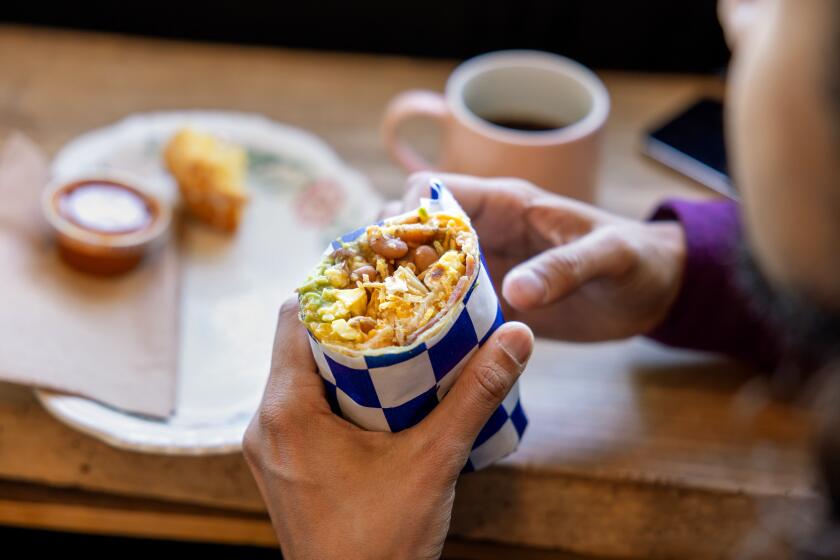Mexico drinks to its roots
REPORTING FROM MEXICO CITY — I entered my first small-town pulquería, a place called Sal Si Puedes, with trepidation. The name itself was a warning: “Escape if You Can.” Two toothless patrons teetering on bar stools gazed as I ordered a pulque. The bartender handed me a chipped mug brimming with a viscous, milky liquid. Its warm, slimy, acrid taste made me want to spit it out. But all eyes were upon me. I managed to quaff enough to impart a pleasant buzz — hmm, this is starting to taste better, I thought to myself. I paid my 3 pesos and made my escape.
Pulque, popular as a workingman’s drink since the time of the Aztecs, slowly lost its appeal as beer, tequila and mezcal took over. Pulquerías became dives, the lowest places to drink into oblivion. Women rarely entered but could buy the drink discreetly from small side windows. Gradually, the number of pulquerías in the Mexico City area dwindled from hundreds to a few dozen.
FOR THE RECORD:
Pulquerias: In the Nov. 10 Food section, an article and two photographs about the growing popularity of Mexico City’s pulquerias should have been credited to Nicholas Gilman, not Nicholas Gill. —
But in the last 10 years, pulquerías have been making a comeback. Mexico’s Facebook generation is embracing and celebrating its culture in ways unknown to its parents, for whom European or American tastes set the standards of chic.
Older, distinctly Mexican traditions are now seen as cool. Pulquerías such as La Risa, the city’s oldest, in business since 1905, and Las Duelistas, with its Aztec-inspired murals, have become fashionable places for young people to meet. One of Mexico’s newest pulquerías, Expendio de Pulques Finos Insurgentes, was opened last year by a group of college-educated idealists whose agenda is to preserve and promote this age-old elixir. Of course, all three places have Facebook pages.
Pulque is fermented agua miel, the fresh sap of the maguey cactus (the same one used to make tequila and mezcal). The result is translucent milky-white, viscous, vaguely effervescent. It has a piquant, yeasty taste with just a hint of sweetness. Though the alcoholic content is low, from 2% to 8%, it can catch up with you — pulquería patrons drink liters of the stuff.
Pulque comes two ways: plain or flavored. Known as curados, flavored pulques may use strawberry, mango, guava, celery, beet or even oatmeal. Though many aficionados imbibe only the pure stuff, beginners may find curados more palatable.
Yeasty, constantly fermenting pulque is made fresh daily because it has a shelf life of less than 24 hours. Attempts to bottle it for export have met with limited success, although some pasteurized versions are available in the U.S., usually flavored and sweetened. So to sample true, fresh pulque, a trip to central Mexico is essential.
Most pulquerías offer botanas (snacks). For the price of a glass (less than $1), a satisfying meal can also be had. At Las Duelistas, which opened in 1930, a different botana, prepared by the bartenders, is served each day. Arturo Garrido Aldana, the third-generation owner, says that years ago, unusual “pre-Hispanic” dishes such as chapulines en salsa roja (grasshoppers in red sauce) were prepared.
Today’s crowd is happy with less challenging fare. Most botanas are simple, light, inexpensive and easy to make at home. A taste of Don Arturo’s black beans with nopalitos reveals a deceptively simple and extraordinarily earthy dish. Equally compelling is his essence-of-the-seashore caldo de camarón offered every Saturday.
Naturally, chefs going back to colonial times have included pulque in their preparations. The most common are chicken and pork in pulque as well as a few salsas. The lighter chicken dish is a variation of a standard European recipe calling for white wine, which wasn’t widely available in Mexico before the 20th century. Cooks learned to adapt, substituting pulque for the wine. The pork stew, a festive dish, is dark, rich and chile-laden, like a mole without the seeds. Both are essentially and soulfully Mexican — like pulque itself. Cooks without access to fresh pulque can adapt backward: substituting beer or wine will produce results close to the original.
Pulquería La Pirata retains an authentic folksy atmosphere. For more than 60 years it has attracted old-timers and hipsters alike in the solidly middle-class neighborhood of Escandón. You enter through swinging saloon doors to a sun-dappled, tiled room painted in mismatched shades of blue and green. The floors are strewn with sawdust, an old wooden bar runs the length of one wall. The portly bartender, Don Santiago, has a look of languid boredom.
You order — “un vaso de apio, por favor” (“a glass of celery-flavored pulque, please”). You’re served a celadon green drink, the glass rim crowned with salt. The first sip goes down smoothly. It’s sweet but not cloying, a little yeasty, tangy and fragrant of celery. The salt gives it a kick. It’s easy to love — a milkshake for grown-ups, an Aztec aperitif.
Finish the glass and order another; help yourself to a free taco from the bar. This is the real thing: aquí es México.
More to Read
Eat your way across L.A.
Get our weekly Tasting Notes newsletter for reviews, news and more.
You may occasionally receive promotional content from the Los Angeles Times.










